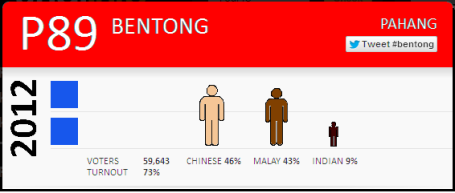
Helen Ang
Almost one-third of the 40 Parliament seats contested by the MCA in the last general election were in Malay-majority areas. The MCA had stood in 13 Malay-majority constituencies in 2008 – see table below.
Bentong
The Malay lifeline gave MCA altogether nine seats, if not for which the Chinese party would have suffered a washout.
But that was five years ago. The MCA stock now has few takers from the Chinese community. It has greatly dipped in value among the Malays too.
The recent development over the Bentong seat raises some questions. Currently the Bentong electoral roll has 46 percent Chinese, 43 percent Malays and 9 percent Indians. Given this demography, would it actually be a safer bet to field an Umno, rather than an MCA candidate for Parliament?
Three other seats can also serve to illustrate a similar predicament arising from the loss of confidence in the MCA.
Padang Serai
Is there any reason at all why BN should not give Padang Serai to the MIC to contest instead of to the MCA?
 Padang Serai in Kedah is a Malay-majority Parliament constituency which has a 22.3 percent Indian electorate. This figure is just a hair’s breadth away from the total of 22.6 percent Chinese voters.
Padang Serai in Kedah is a Malay-majority Parliament constituency which has a 22.3 percent Indian electorate. This figure is just a hair’s breadth away from the total of 22.6 percent Chinese voters.
In 2008, Padang Serai was lost by Datuk Boey Chin Gan (MCA) to N. Gobalakrishnan (PKR).
The general consensus is that Indian support has returned to BN whereas the Chinese vote has moved even further away from the ruling party.
Wangsa Maju
Another notable seat lost by the MCA in GE12 was Wangsa Maju, a 52.5 percent Malay-majority area.
The present incumbent Wee Choo Keong is popular with the Malays partly due to his Kelantan origin. Wee had won the seat on a PKR ticket by a slim margin of 150 votes but later turned independent in May 2010.
His probable challenger is Yew Teong Look of the MCA who has continued to service the area despite his 2008 loss. Yew is known to the Chinese ground as a diligent worker and is most likely to receive the nod again from his party.
Meanwhile PKR is tipped to field Dr Tan Tee Kwong, a former Deputy Land and Cooperative Development Minister and ex-Gerakan man.
Wangsa Maju is an interesting proposition in the light of the Pandan imbroglio. If the leaks are to be believed, BN chairman Najib Razak may go over the head of the MCA selection committee to (re)nominate former MCA president Ong Tee Keat to defend the seat.
Since Ong does not have the endorsement of his own party, he would be a direct BN candidate if he were to stand in Pandan.
A precedent had been set by P. Kamalanathan in the 2010 Hulu Selangor by-election. The MIC’s choice was its then deputy president G. Palanivel but this recommendation was overridden by the BN war room. Palanivel had narrowly lost by 198 votes to PKR’s Zainal Abidin Ahmad earlier in the March 8, 2008 general election.
The same procedure of the high command (read: Umno) bypassing the BN satellite nomination might apply to Wee Choo Keong if MCA is considered unmarketable.
Bandar Tun Razak
Khalid Ibrahim, who is Ijok state assemblyman, is concurrently holding the Bandar Tun Razak seat. The Selangor Menteri Besar is reputedly unpopular with his Federal Territory constituents.
Despite it being a Malay-majority seat (52.7%), BN had put up an MCA candidate here in 2008.
In Malay-majority mixed areas, the tsunami wave which was in favour of Chinese opposition candidates had conversely run counter to the established Chinese political figures. Thus an MCA top gun Tan Chai Ho – three-term MP cum MCA Federal Territory chairman – lost his bid for Bandar Tun Razak.
In parallel, fellow MCA big name Deputy Home Minister Fu Ah Kiow lost to PKR’s Fuziah Salleh in Kuantan, another Malay-majority area.
End of BN shelf life
The defeat of both MCA stalwarts in Bandar Tun Razak and Kuantan reflected a trend where Chinese voters – 39.5% and 35.9% respectively in the two constituencies – rejected the BN Chinese component party while at the same time Malay voters opted for a same race opposition candidate.
MCA’s failure in GE12 signalled an unravelling of the BN formula.
The BN quid pro quo is necessarily made to work for the MIC because there are no outright Indian-majority Parliament seats. The one with the highest percentage of Indians is Kota Raja, Selangor with roughly 28 percent Indian voters.
In return for their delivery of Indian votes, the MIC are guaranteed a quota of seats. The BN branding ensures that supporters of the coalition will cast their ballots across ethnic lines.
The MCA however failed to hold up to its end of this communal bargaining arrangement when in 2008, Chinese voters in the peninsula refused to tick thedacing symbol.
Despite the MCA still managing to collect a clutch of Malay-majority seats, more Malay voters were themselves visibly wavering in faith.
Thus in the Parliamentary constituencies of Bandar Tun Razak, Kuantan, Hulu Selangor, Kota Raja and Teluk Kemang as well as in the state seats of Lunas and Pasir Panjang among others, the BN’s Chinese and Indian candidates lost to the Malay opposition.
Not many today believe there is much chance for the MCA to regain their foothold. Unlike in the GE12, this time the party’s free fall will no longer be arrested by the Malay pro-Umno voters.








No comments:
Post a Comment
Note: Only a member of this blog may post a comment.